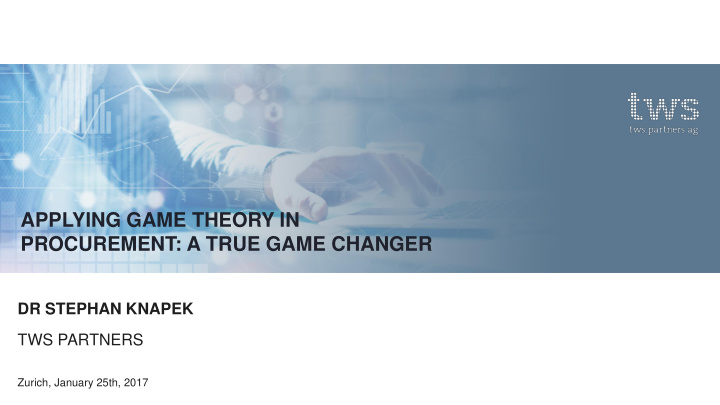



APPLYING GAME THEORY IN PROCUREMENT: A TRUE GAME CHANGER DR STEPHAN KNAPEK TWS PARTNERS Zurich, January 25th, 2017
TWS PARTNERS – Our Business Founded in 2001 More than 50 game theory as a spin off from industry and industrial economics and research experts Over 2.000 projects Projects addressed more than €150bn already implemented Unique expertise: we bring game theory to life for businesses
OUR CLIENTS ARE MARKET LEADERS AND HIDDEN CHAMPIONS WHO WANT TO BE AT THE CUTTING EDGE Automotive High-Tech Pharmaceutical Consumer goods and Transport and Telecommunications and Chemical and others WE WORK WITH THEM TO UNLOCK THE TRUE POTENTIAL OF GAME THEORY WHICH THEN CREATES A SUSTAINABLE COMPETITIVE ADVANTAGE
TWS PARTNERS – Core competences Game theory helps Procurement on different levels Process & Process & organisation organisation Market design Cross- Cross- functional functional Negotiation Negotiation integration integration design design TODAY
MONA LISA AUCTION Everyone knows Da Vinci’s famous How would you bid for ‘Mona Lisa’ painting, the Mona Lisa - in different auction formats?
MONA LISA AUCTION Setting • You try to buy ‘Mona Lisa’ as a proxy, your client would spend up to CHF 100m • His only rule: you can spend all the money, but don’t come back without the painting • You do not know what the other bidders’ walkaway positions are, but let’s assume the auctioneer assumes asymmetric valuations How should the auctioneer structure the negotiation and why?
MONA LISA AUCTION Faced with the risk of “losing” millions, In this case, a classical English Auction will end at the second highest a risk-averse bidder would accept a valuation, e.g. at CHF 50m price way above CHF 50m Seemingly insignificant changes in the negotiation design can make all of the difference
MAIN TAKEAWAYS 1 Prepare thoroughly the internal commitment for all possible outcomes of a negotiation 2 Tailor the negotiation design to the circumstances at hand 3 Translate the internal commitment to clear boundary conditions to increase Purchasing’s bargaining leverage 4 Communicate the rules transparently and clearly and emphasise the suppliers & process determine who wins – not the negotiator
USE OF COST TO THE BUSINESS INSTEAD OF QUALITATIVE MEASURES QUALITATIVE TRAFFIC LIGHT MONETARY EVALUATION SCORING CATEGORISATION 82/100 CHF NOT ENSURING A TRUE LIKE-FOR-LIKE COMMON UNIT OF MEASURE
TRUE TOTAL-VALUE-OF-OWNERSHIP +CHF - CHF UNKNOWN +CHF REDUCED SUPPLIER MAINTAIN- - CHF ANCE INDUSTRY TRACK ACCESS TO RECORD INNOVATION QUOTED OBJECTIVE PRICE VALUE Turns the cross-functional assessment into a true Total-Value-of-Ownership
ACHIEVING OBJECTIVITY …neutralises preferences Monetising all • Benefits • Costs • Preferences • Risks Supplier A Supplier B • Strategic considerations… Methodology exposes ‘hidden agendas’ and prevents ‘vetoing of options’
MAIN TAKEAWAYS 1 Put Procurement at the centre of the decision making process 2 Integrates subjectivity & preferences into the evaluation process – all arguments are turned into their real costs 3 Grant buyers the authority to commit within agreed parameters 4 Allow closed loop linking supplier performance back into it
BRINGING IT TO LIFE… Now let’s look at how this works in practice… ….a joint case study with
Recommend
More recommend